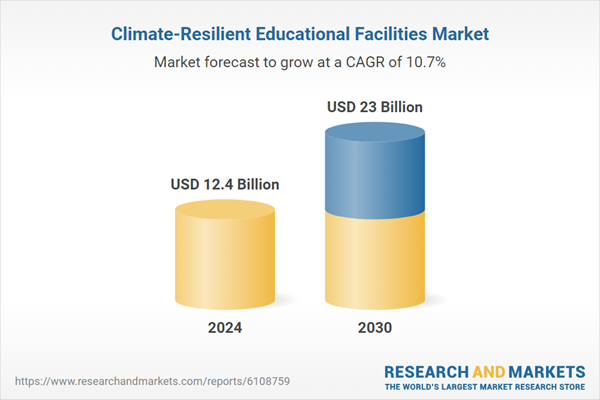Speak directly to the analyst to clarify any post sales queries you may have.
10% Free customizationThis report comes with 10% free customization, enabling you to add data that meets your specific business needs.
Additionally, energy efficiency and sustainability are becoming core to school design through the integration of solar panels, rainwater harvesting, and advanced HVAC systems. Efforts to ensure equitable education are driving infrastructure upgrades in underserved areas, while trends such as biophilic and nature-based design are enhancing cognitive development. Technological innovations and collaboration among stakeholders are further advancing climate-resilient education infrastructure globally.
Key Market Drivers
Escalating Climate Risks and Need for Disaster-Resilient Infrastructure
The growing frequency and intensity of climate-related events - including floods, heatwaves, hurricanes, and wildfires - are posing serious threats to educational systems worldwide. These events damage infrastructure, displace students, and interrupt academic continuity. In response, educational authorities and governments are increasingly investing in resilient infrastructure to protect learning environments. In flood-prone regions, schools are being elevated, constructed with water-resistant materials, and outfitted with drainage systems.For areas with rising temperatures, passive cooling techniques such as cross-ventilation, reflective roofing, and solar shading are being employed. Wildfire-risk zones are seeing the use of non-combustible materials and protective landscaping. This movement is supported by global frameworks like the Sendai Framework for Disaster Risk Reduction and SDG 4, which emphasize safe and resilient education. Post-disaster recovery funds from international organizations and governments - such as those deployed after Hurricane Maria in Puerto Rico and the 2022 floods in Pakistan - are increasingly earmarked for rebuilding schools to climate-resilient standards.
Key Market Challenges
High Initial Capital Costs and Limited Budget Allocation
A key barrier to the development of climate-resilient educational infrastructure is the high initial cost of construction and retrofitting. Resilient facilities typically require advanced materials, sustainable energy systems, and disaster-resistant architectural features - all of which drive up capital expenses compared to traditional building approaches.This cost burden is particularly acute in low- and middle-income countries, where education budgets are often stretched thin and prioritized for pressing needs such as teacher hiring, digital tools, and sanitation. As a result, resilience projects are frequently deferred. Even in high-income nations, financial competition from other sectors often limits public investment in educational infrastructure. The high upfront costs can stall long-term resilience strategies, leaving many schools vulnerable to climate threats.
Key Market Trends
Integration of Nature-Based and Biophilic Design Approaches
An increasingly prominent trend in this market is the adoption of nature-based and biophilic design principles within educational infrastructure. These approaches incorporate natural elements like greenery, daylight, and airflow to promote climate adaptability and enhance student well-being. To counter urban heat and manage stormwater, schools are installing green roofs, vertical gardens, and shaded courtyards. Such designs not only regulate internal temperatures but also reduce dependence on artificial cooling systems.Biophilic features support mental and emotional health, while outdoor classrooms and open-air spaces help maintain education continuity during ventilation-related disruptions, such as those experienced during the COVID-19 pandemic. Additionally, these green features act as living educational tools, fostering awareness of sustainability topics including biodiversity and renewable resources. This trend is particularly impactful in densely populated cities, where schools provide critical access to green space and promote community resilience.
Key Market Players
- Skanska AB
- AECOM
- Turner Construction Company
- Stantec Inc.
- Gensler
- Jacobs Solutions Inc.
- Balfour Beatty plc
- Lendlease Group
Report Scope:
In this report, the Global Climate-Resilient Educational Facilities Market has been segmented into the following categories, in addition to the industry trends which have also been detailed below:Climate-Resilient Educational Facilities Market, By Resilience Solution Type:
- Flood-Resistant Infrastructure
- Heat-Resistant & Ventilated Buildings
- Renewable Energy Integration
- Disaster-Resistant Construction
- Water Conservation & Management Systems
- Others
Climate-Resilient Educational Facilities Market, By Educational Institution Type:
- Primary Schools
- Secondary/High Schools
- Colleges & Universities
- Technical & Vocational Training Centers
- Special Education Facilities
- Others
Climate-Resilient Educational Facilities Market, By Region:
- North America
- United States
- Canada
- Mexico
- Europe
- Germany
- France
- United Kingdom
- Italy
- Spain
- Asia Pacific
- China
- India
- Japan
- South Korea
- Australia
- South America
- Brazil
- Colombia
- Argentina
- Middle East & Africa
- Saudi Arabia
- UAE
- South Africa
Competitive Landscape
Company Profiles: Detailed analysis of the major companies present in the Global Climate-Resilient Educational Facilities Market.Available Customizations:
With the given market data, the publisher offers customizations according to a company's specific needs. The following customization options are available for the report.Company Information
- Detailed analysis and profiling of additional market players (up to five).
This product will be delivered within 1-3 business days.
Table of Contents
Companies Mentioned
- Skanska AB
- AECOM
- Turner Construction Company
- Stantec Inc.
- Gensler
- Jacobs Solutions Inc.
- Balfour Beatty plc
- Lendlease Group
Table Information
| Report Attribute | Details |
|---|---|
| No. of Pages | 188 |
| Published | July 2025 |
| Forecast Period | 2024 - 2030 |
| Estimated Market Value ( USD | $ 12.4 Billion |
| Forecasted Market Value ( USD | $ 23 Billion |
| Compound Annual Growth Rate | 10.7% |
| Regions Covered | Global |
| No. of Companies Mentioned | 8 |









